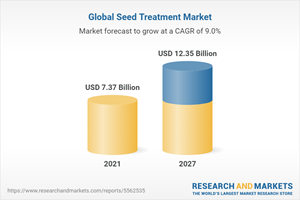Global Seed Treatment Market Report (2022 to 2027) - Industry Trends, Share, Size, Growth, Opportunity and Forecasts

Global Seed Treatment Market

Dublin, July 15, 2022 (GLOBE NEWSWIRE) -- The "Seed Treatment Market: Global Industry Trends, Share, Size, Growth, Opportunity and Forecast 2022-2027" report has been added to ResearchAndMarkets.com's offering.
The global seed treatment market reached a value of US$ 7.37 Billion in 2021. Looking forward, the publisher expects the market to reach US$ 12.35 Billion by 2027, exhibiting at a CAGR of 8.9% during 2022-2027. Keeping in mind the uncertainties of COVID-19, we are continuously tracking and evaluating the direct as well as the indirect influence of the pandemic. These insights are included in the report as a major market contributor.
The treatment of seeds involves the application of chemical or organic agents for improving the quality and providing protection to the grain. Eco-friendly pesticides and fungicides that prevent pathogens and rodents from damaging the crop are widely used in the process of seed treatment.
These pesticides and fungicides are used in different concentrations according to the requirements of the crop or the soil. The treatment process involves various stages such as exposing the seeds to the sun, immersing them in nutrient-rich water, coating, priming, phytosanitary treatment, pelleting, and microbial inoculation.
With the rapidly increasing global population, there has been a significant rise in the demand for food grains, which calls for the production of higher and enhanced yields. Furthermore, effective seed treatment prevents seed and soil-borne infections, aids in improving the germination time and enhances the overall productivity. It also averts the ill-effects of agrochemical residues in the crop, thus aptly meeting the soaring demand for chemical-free foods.
Moreover, extensive research and development in bio-farming techniques coupled with the production of energy-efficient, environment-friendly and economical means of seed treatment have also catalyzed the market growth.
Competitive Landscape:
The report has also analysed the competitive landscape of the market with some of the key players being Bayer, Syngenta, BASF, DOW Agrosciences, Dupont, Nufarm, FMC, Arysta Lifescience, Sumitomo Chemical, UPL, Incotec, Germains, Advanced Biological Marketing Inc, etc.
Key Questions Answered in This Report:
How has the global seed treatment market performed so far and how will it perform in the coming years?
What are the key regional markets in the global seed treatment industry?
What has been the impact of COVID-19 on the global seed treatment market?
What is the breakup of the market based on the type?
What is the breakup of the market based on the application technique?
What is the breakup of the market based on the crop type?
What is the breakup of the market based on the function?
What are the various stages in the value chain of the global seed treatment industry?
What are the key driving factors and challenges in the global seed treatment industry?
What is the structure of the global seed treatment industry and who are the key players?
What is the degree of competition in the global seed treatment industry?
What are the profit margins in the global seed treatment industry?
Key Topics Covered:
1 Preface
2 Scope and Methodology
3 Executive Summary
4 Introduction
4.1 Overview
4.2 Key Industry Trends
5 Global Seed Treatment Market
5.1 Market Overview
5.2 Market Performance
5.3 Impact of COVID-19
5.4 Market Breakup by Type
5.5 Market Breakup by Application Technique
5.6 Market Breakup by Crop Type
5.7 Market Breakup by Function
5.8 Market Breakup by Region
5.9 Market Forecast
6 Market Breakup by Type
6.1 Chemical Seed Treatment
6.1.1 Market Trends
6.1.2 Market Forecast
6.2 Non-Chemical Seed Treatment
6.2.1 Market Trends
6.2.2 Market Forecast
7 Market Breakup by Application Technique
7.1 Seed Coating
7.1.1 Market Trends
7.1.2 Market Forecast
7.2 Seed Dressing
7.2.1 Market Trends
7.2.2 Market Forecast
7.3 Seed Pelleting
7.3.1 Market Trends
7.3.2 Market Forecast
7.4 Others
7.4.1 Market Trends
7.4.2 Market Forecast
8 Market Breakup by Crop Type
8.1 Corn/Maize
8.1.1 Market Trends
8.1.2 Market Forecast
8.2 Soybean
8.2.1 Market Trends
8.2.2 Market Forecast
8.3 Wheat
8.3.1 Market Trends
8.3.2 Market Forecast
8.4 Rice
8.4.1 Market Trends
8.4.2 Market Forecast
8.5 Cotton
8.5.1 Market Trends
8.5.2 Market Forecast
8.6 Others
8.6.1 Market Trends
8.6.2 Market Forecast
9 Market Breakup by Function
9.1 Seed Protection
9.1.1 Market Trends
9.1.2 Market Forecast
9.2 Seed Enhancement
9.2.1 Market Trends
9.2.2 Market Forecast
9.3 Others
9.3.1 Market Trends
9.3.2 Market Forecast
10 Market Breakup by Region
11 SWOT Analysis
12 Value Chain Analysis
13 Porters Five Forces Analysis
14 Price Analysis
14.1 Price Indicators
14.2 Price Structure
14.3 Margin Analysis
15 Competitive Landscape
15.1 Market Structure
15.2 Key Players
15.3 Profiles of Key Players
15.3.1 Bayer
15.3.2 Syngenta
15.3.3 BASF
15.3.4 DOW Agrosciences
15.3.5 Dupont
15.3.6 Nufarm
15.3.7 FMC
15.3.8 Arysta Lifescience
15.3.9 Sumitomo Chemical
15.3.10 UPL
15.3.11 Incotec
15.3.12 Germains
15.3.13 Advanced Biological Marketing Inc
For more information about this report visit https://www.researchandmarkets.com/r/grb1zc
Attachment
CONTACT: CONTACT: ResearchAndMarkets.com Laura Wood, Senior Press Manager press@researchandmarkets.com For E.S.T Office Hours Call 1-917-300-0470 For U.S./CAN Toll Free Call 1-800-526-8630 For GMT Office Hours Call +353-1-416-8900


 Yahoo Finance
Yahoo Finance 
